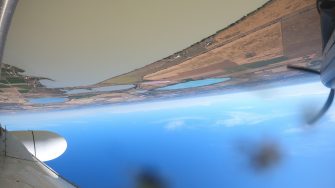
Date: Thursday, October 22, 2020
Project: Eastern Australian Waterbird Survey
Observers: John Porter UNSW/DPIE, Shannon Dundas NSW DPIE
Pilot: James Barkell NSW National Parks & Wildlife Service DPIE
The morning was clear as we left the irrigated fields of Deniliquin behind and flew west to Kerang Lakes – a Ramsar listed patchwork quilt of lakes and wetlands. Some of the wetlands are saline, causing the water to become clear with macrophytes carpeting the bottom. The larger freshwater lakes are used to hold water for irrigation and rising groundwater salinity is a major threat. When filled, the more temporary wetlands can provide vital breeding and feeding habitat for large numbers of waterbirds.
Looking south over Kangaroo Lake
The deeper lakes, including Kangaroo lake, had relatively few birds but a couple of the shallower more brackish lakes such as Lake Cullen had thousands of grey teal, hardhead, black Swans, coot and hundreds of mountain duck, stilts and avocets – a welcome contrast to mostly low counts of the previous day. Middle Lake had no ibis breeding – for the first time in several years. Saline water supporting red algae has turned the water pink in Duck Lake – its high salinity means there were no waterbirds.
Counting over saline pondages on Duck Lake
From Kerang we jumped about 160km north east towards Hay and survey band 3 counting over mostly irrigation storages which had low numbers of birds and no breeding. After refuelling at Griffith, we continued eastward, hoping to beat the complex low pressure system converging on the east coast. Our first target was another Ramsar site - Tuckerbill and Fivebough Swamps which were dry and drying back respectively with low numbers of birds on Fivebough, mainly grey teal, whiskered terns, black swan, spoonbills, stilts and avocets. We completed our counts near Bowral in NSW southern tablelands before heading back to Bankstown.
Blog by John Porter
